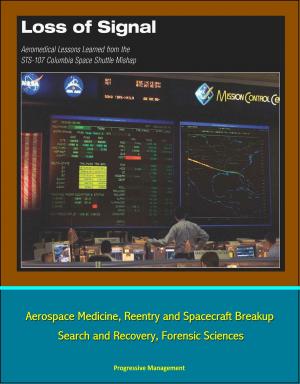Space Shuttle NASA Mission Reports: 1995 Missions, STS-63, STS-67, STS-71, STS-70, STS-69, STS-73, STS-74
Nonfiction, Science & Nature, Science, Physics, Astronomy, Other Sciences, History| Author: | Progressive Management | ISBN: | 9781465874351 |
| Publisher: | Progressive Management | Publication: | January 12, 2012 |
| Imprint: | Smashwords Edition | Language: | English |
| Author: | Progressive Management |
| ISBN: | 9781465874351 |
| Publisher: | Progressive Management |
| Publication: | January 12, 2012 |
| Imprint: | Smashwords Edition |
| Language: | English |
These official final program mission reports issued by the NASA Johnson Space Center cover missions in 1995: STS-63, STS-67, STS-71, STS-70, STS-69, STS-73, and STS-74. In these thorough reports, with information and specifics not available on NASA website mission descriptions, each orbiter system is reviewed in detail along with technical information on performance and anomalies.
STS-63: The primary objectives of the STS-63 mission were to perform the Mir rendezvous operations, accomplish the Spacehab-3 experiments, and deploy and retrieve the Shuttle Pointed Autonomous Research Tool for Astronomy-204 (SPARTAN-204) payload.
STS-67: The primary objective of this flight was to successfully perform the operations of the Ultraviolet Astronomy (ASTRO-2) payload. Secondary objectives of this flight were to complete the operations of the Protein Crystal Growth - Thermal Enclosure System (PCG-TES), the Protein Crystal Growth - Single Locker Thermal Enclosure System (PCG-STES), the Commercial Materials Dispersion Apparatus ITA Experiments (CMIX), the Shuttle Amateur Radio Experiment-ll (SAREX-II), the Middeck Active Control Experiment (MACE), and two Get-Away Special (GAS) payloads.
STS-71: The primary objectives of this flight were to rendezvous and dock with the Mir Space Station and perform on-orbit joint U.S.-Russian life sciences investigations, logistical resupply of the Mir Space Station, return of the United States astronaut flying on the Mir, the replacement of the Mir-18 crew with the two-cosmonaut Mir-19 crew, and the return of the Mir-18 crew to Earth.
STS-70: The primary objective of this flight was to deploy the Tracking and Data Relay Satellite-G/lnertial Upper Stage (TDRS-G/IUS).
STS-69: The primary objectives of this flight were to perform the operations necessary to fulfill the requirements of Wake Shield Facility (WSF), and SPARTAN-201.
STS-73: The primary objective of this flight was to successfully perform the planned operations of the United States Microgravity Laboratory (USML) -2 payload.
STS-74: The primary objectives of this flight were to rendezvous and dock with the Mir Space Station and perform life sciences investigations. The Russian Docking Module (DM) was berthed onto the Orbiter Docking System (ODS) using the Remote Manipulator System (RMS), and the Orbiter docked to the Mir with the DM. When separating from the Mir, the Orbiter undocked, leaving the DM attached to the Mir.
These official final program mission reports issued by the NASA Johnson Space Center cover missions in 1995: STS-63, STS-67, STS-71, STS-70, STS-69, STS-73, and STS-74. In these thorough reports, with information and specifics not available on NASA website mission descriptions, each orbiter system is reviewed in detail along with technical information on performance and anomalies.
STS-63: The primary objectives of the STS-63 mission were to perform the Mir rendezvous operations, accomplish the Spacehab-3 experiments, and deploy and retrieve the Shuttle Pointed Autonomous Research Tool for Astronomy-204 (SPARTAN-204) payload.
STS-67: The primary objective of this flight was to successfully perform the operations of the Ultraviolet Astronomy (ASTRO-2) payload. Secondary objectives of this flight were to complete the operations of the Protein Crystal Growth - Thermal Enclosure System (PCG-TES), the Protein Crystal Growth - Single Locker Thermal Enclosure System (PCG-STES), the Commercial Materials Dispersion Apparatus ITA Experiments (CMIX), the Shuttle Amateur Radio Experiment-ll (SAREX-II), the Middeck Active Control Experiment (MACE), and two Get-Away Special (GAS) payloads.
STS-71: The primary objectives of this flight were to rendezvous and dock with the Mir Space Station and perform on-orbit joint U.S.-Russian life sciences investigations, logistical resupply of the Mir Space Station, return of the United States astronaut flying on the Mir, the replacement of the Mir-18 crew with the two-cosmonaut Mir-19 crew, and the return of the Mir-18 crew to Earth.
STS-70: The primary objective of this flight was to deploy the Tracking and Data Relay Satellite-G/lnertial Upper Stage (TDRS-G/IUS).
STS-69: The primary objectives of this flight were to perform the operations necessary to fulfill the requirements of Wake Shield Facility (WSF), and SPARTAN-201.
STS-73: The primary objective of this flight was to successfully perform the planned operations of the United States Microgravity Laboratory (USML) -2 payload.
STS-74: The primary objectives of this flight were to rendezvous and dock with the Mir Space Station and perform life sciences investigations. The Russian Docking Module (DM) was berthed onto the Orbiter Docking System (ODS) using the Remote Manipulator System (RMS), and the Orbiter docked to the Mir with the DM. When separating from the Mir, the Orbiter undocked, leaving the DM attached to the Mir.















